A horse’s tail can be as expressive as their ears. The tail talks, but like with ears, you need to know the context. You need to know the horse. A swishing tail can mean I’m eager or I’m frustrated or I hurt or there’s an annoying fly or you’re annoying.
When Tonka feels good at the trot, the dock (base) of his tail moves along with his haunches and his lovely thick tail swings back and forth, almost as if he’s wagging it. People watching always smile. This video was recently taken at the start of a jumping lesson.
When Tonka is hurting, instead of moving forward, he balks and expresses discomfort by raising his tail and thwumping it to the side. This is an older video from when his sacroiliac joint was causing pain. Here we’re at the walk. As I apply my legs to ask for a trot, the first thing he does is flick his tail sideways. Then Tonka swings his quarters to avoid moving forward. I knew that something was amiss at the flick. This was the decisive moment when I decided to call the veterinarian.
Horses swish their tails to brush off flies. Flies are ever so bothersome.
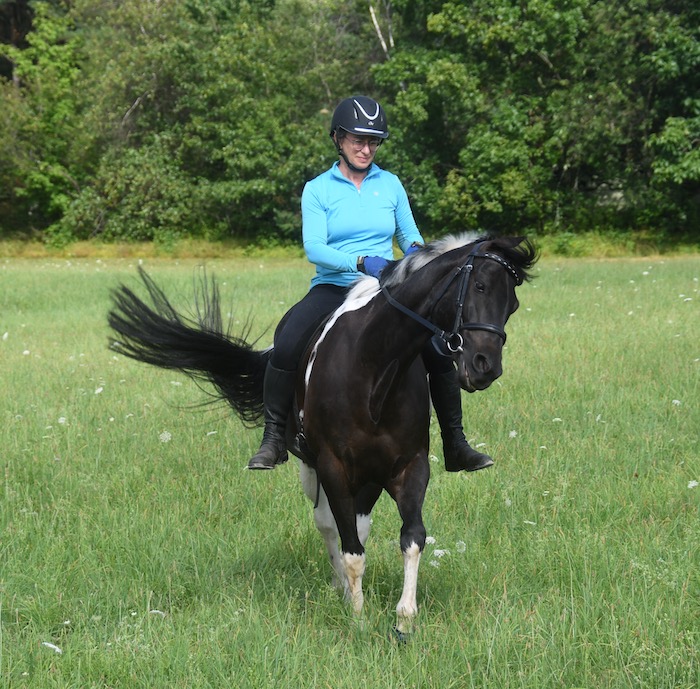
The action of swishing a tail becomes linked in the horse’s mind to when they’re annoyed. When there’s something else that’s irritating, they’ll use that same tail swish. This is called emancipated behavior. What the behavior was originally associated with is long gone, but they now generalize it to other things. (I’ve written about emancipated behavior in this blogpost.)
Here Tonka is very ticked off at me. I know not just because of the pinned ears and that tight face. That tail swiping the air is telling me loud and clear what he thinks.
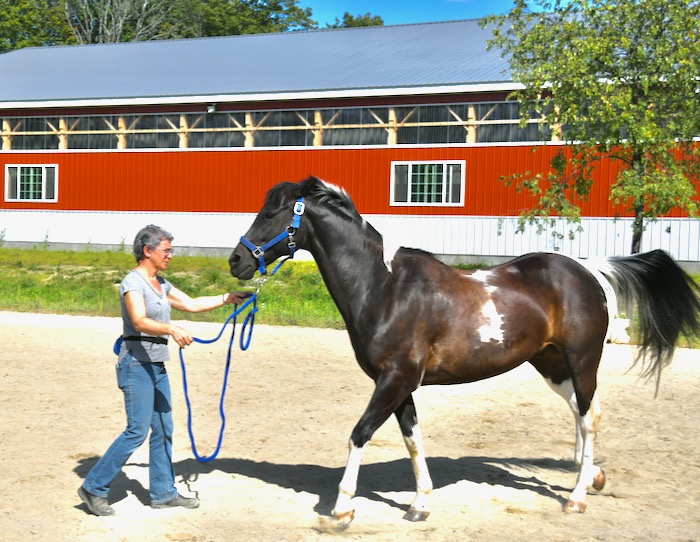
I change up what I’m asking, and how I’m asking for it, and Tonka’s demeanor totally changes. Look at the tail. (This photo was taken less than a minute after the first. Listen to what your horse is saying and you can deescalate dangerous situations quickly.)

Tonka has recently started to swish his tail in the lessons. Is he annoyed? Hurting? Or is it something else? Taken out of context, this video could show a horse that has back pain.
Actually, my horse is having a snit.
Why?
Because we were headed towards a jump, but I circled him away to establish a better trot. Tonka was ticked off at being turned away from the jump. He loves to jump. Fortunately, that tail swish was the extent of his tantrum.
But Tonka is swishing his tail during these jumping lessons at other times, too. He doesn’t look upset. He isn’t acting like a horse that hurts. Here’s a photo before the jump. That tail is flicked with the same energy that he uses to whack deer flies.
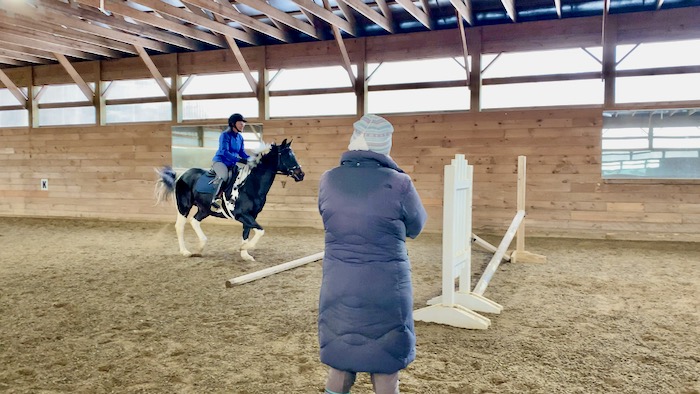
This is after. It’s like a visual exclamation point on the landing.
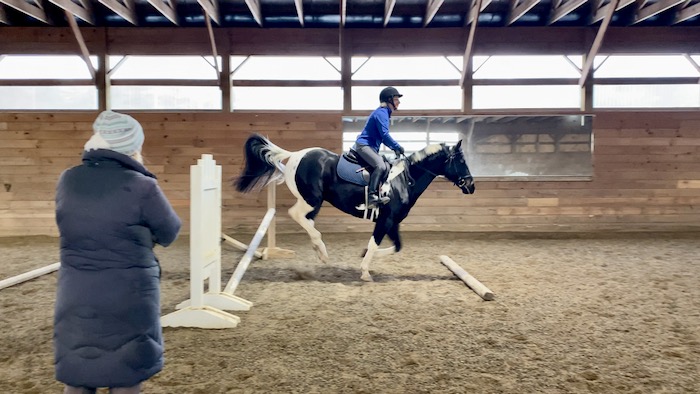
I think that Tonka is showing enthusiasm. There’s a mare at the barn who also loves to jump. When she knows she’s about to jump a course, she can barely contain her energy. She’d prefer if she were allowed to go faster and higher. She wants to behave, but she’s conflicted. Rein her in and the excess energy literally goes out her tail. She flips it over her back. She swings it side to side. Her tail is active and expressive. Tonka is starting to do the same.
But, it’s complicated. Tonka took a jump really big. Perfect form, but did he ever round his back in a bascule!
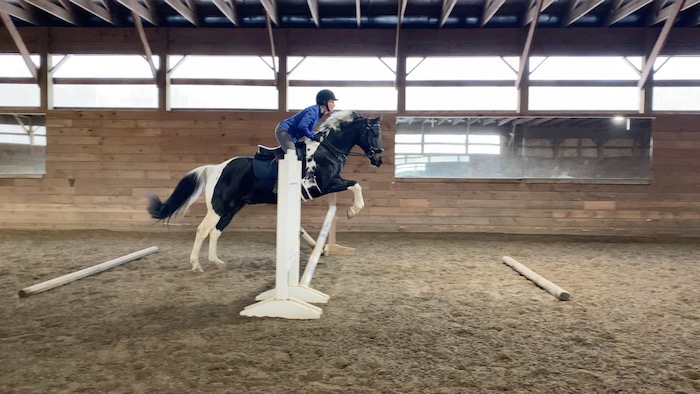
A few strides after landing Tonka flicked his tail and took a couple of uneven steps. He’d overdone it. He kept wringing his tail. This was not enthusiasm. This was discomfort. I had Tonka trot big and loose and stretch across his topline. It took twice around the arena before he was able to get the kinks out and relax the base of his tail.
Then he was more than ready to jump some more.
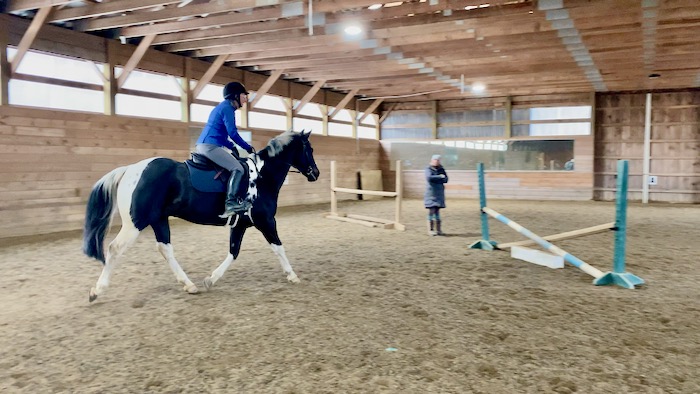
Interpreting what Tonka is saying with his tail isn’t clearcut. There’s no rosetta stone for this. But there’s lots of language going on, and I’ll be listening.
Does your horse have an expressive tail? What are you hearing?


Hi Terry
I cant get the videos to play from either my phone or laptop. I’d love to see Tonka tail swishing!
Thank you for letting me know! IT Guy Steve had a challenging time fixing it, but he did! The tail swish is now visible 🙂
Same video link posted three times — I wouldn’t want you to think we don’t read/look at what you post!
I’m so appreciative of your comment. WordPress changed up protocols on videos, with no warning or info. Your comment gave us a heads up. ITGuy/husband extaordinaire fixed it after hours of work.
Having ridden horse who seem to turn on their inner afterburners while jumping a course, eyes wide and tail whipping around, scrambling to go faster,I have always thought it was more a sign of anxiety or fear as enthusiasm. Sort of like race horses trotting sideways as they enter the starting gate, an act that is the anticipation of terror at the deafening starting bell designed to scare the horse into bolting. Much more acute than doing simple jumps in a quiet arena, surely. This said, I have a friend who rides an open jumper who is practically hysterical when aimed at a huge fence, but dead calm between jumps, and before and after. She is certain that her horse just loves the feeling of jumping, and I believe her. He hasn’t had an injury in years. I wonder if you’ve ever felt anxiety from Tonka while jumping, especially when he takes it too ‘big’ and it hurts? You know him so well.
I think that there are some horses that love the challenge and adrenalin rush of jumping high and fast. Excitement always has an edge of anticipation to it. It’s a grey area and can spill over either direction. Err on the side of too much caution and life is boring. Push too hard and it’s no longer fun and can hurt. Any athletic life is like that. At this point, I could turn towards a jump 15 strides out, drop the reins and close my eyes and Tonka would head right to it and jump. We’ve had only 7 jumping sessions. He’s learning how big is right for him. He doesn’t like to go too small, either. He’s taken cross-rails like trotting poles, (the jumps really are tiny!) but never repeats that, even though he could. The next time he comes around and jumps it with perfect form, knees up. Sure looks like he’s enjoying himself. The other tell is that after taking a few jumps, and then a walk break, that when I pick up the reins there’s no hesitation. I can feel the engine rev and he looks around for what the next line of jumps might be. When Tonka doesn’t want to do something, he stops. He can be quite clear that way 🙂
This whole topic is so interesting. You mention that we need to pay attention to context, like we do with ears. Do you have any blog posts, or other places to gather information from that talk more about ears? I’m looking for more support for the idea that ears pointed back can be concentrating or something, other than grouchy, depending on the context.
I’m working on a new blogpost about ears and attitude. But until then, take a look at this one that I wrote awhile back. https://cooperativehorse.com/2015/10/believe-the-ears/